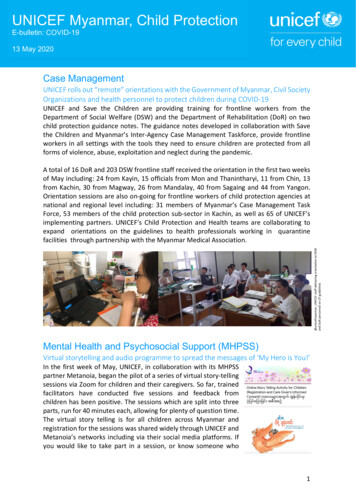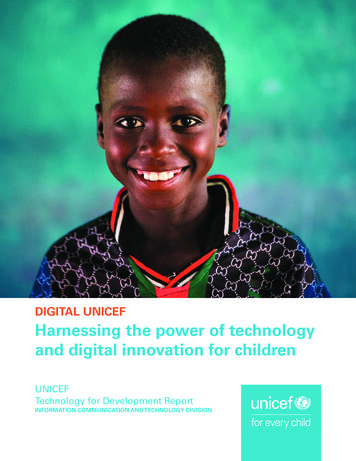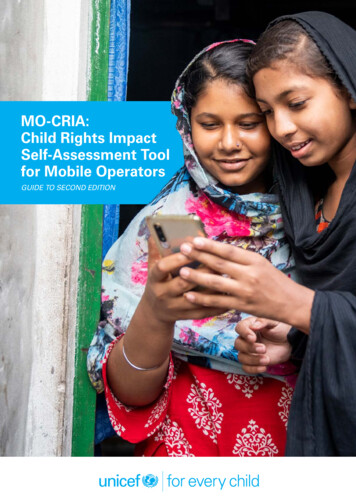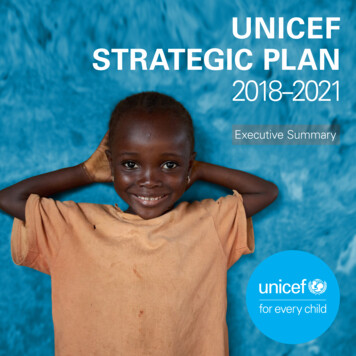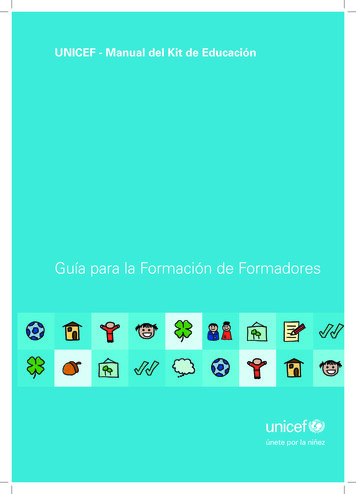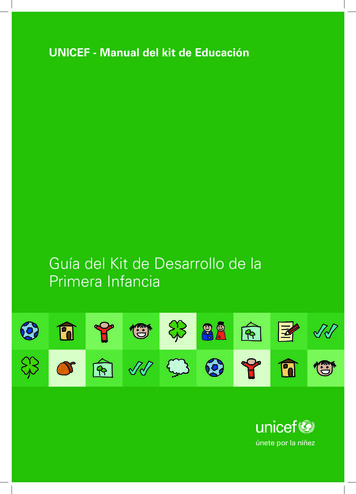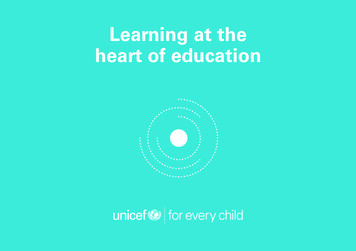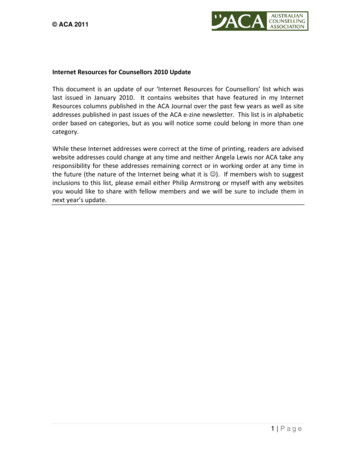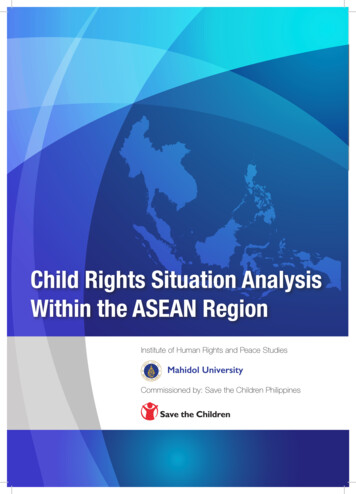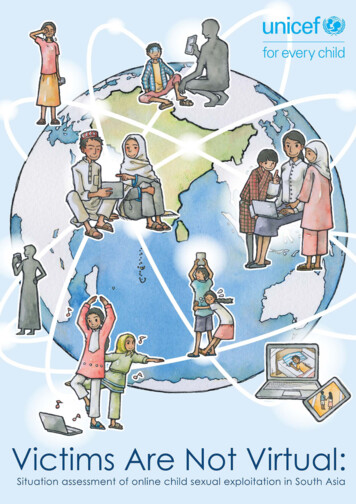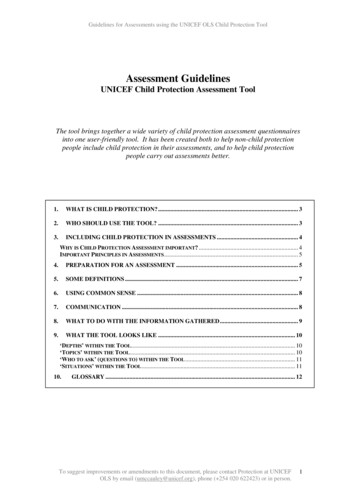
Transcription
Guidelines for Assessments using the UNICEF OLS Child Protection ToolAssessment GuidelinesUNICEF Child Protection Assessment ToolThe tool brings together a wide variety of child protection assessment questionnairesinto one user-friendly tool. It has been created both to help non-child protectionpeople include child protection in their assessments, and to help child protectionpeople carry out assessments better.1.WHAT IS CHILD PROTECTION? . 32.WHO SHOULD USE THE TOOL? . 33.INCLUDING CHILD PROTECTION IN ASSESSMENTS . 4WHY IS CHILD PROTECTION ASSESSMENT IMPORTANT? . 4IMPORTANT PRINCIPLES IN ASSESSMENTS . 54.PREPARATION FOR AN ASSESSMENT . 55.SOME DEFINITIONS . 76.USING COMMON SENSE . 87.COMMUNICATION . 88.WHAT TO DO WITH THE INFORMATION GATHERED . 99.WHAT THE TOOL LOOKS LIKE . 10‘DEPTHS’ WITHIN THE TOOL. 10‘TOPICS’ WITHIN THE TOOL. 10‘WHO TO ASK’ (QUESTIONS TO) WITHIN THE TOOL . 11‘SITUATIONS’ WITHIN THE TOOL . 1110.GLOSSARY . 12To suggest improvements or amendments to this document, please contact Protection at UNICEFOLS by email (umccauley@unicef.org), phone ( 254 020 622423) or in person.1
Guidelines for Assessments using the UNICEF OLS Child Protection ToolThese guidelines do not explain how to use the technology (e.g. which buttons topress), which is covered in the “Quick Training Session” presentation on the CD.If you are using the electronic version of the tool, these guidelines and thatpresentation complement each other and should be read together. It you areusing the paper version, ignore reference to the electronic tool in this document.To suggest improvements or amendments to this document, please contact Protection at UNICEFOLS by email (umccauley@unicef.org), phone ( 254 020 622423) or in person.2
Guidelines for Assessments using the UNICEF OLS Child Protection Tool1.What is Child Protection?The child focused agencies operating in Sudan have reached an agreed definition ofchild protection:Activities that reduce exposure of children to abuse, neglect and exploitationand that assist them to achieve their basic rights to care, protection andjusticeSuch child protection activities are currently undertaken by a variety of actors inSudan. An example might be the attempt to put abducted children back in touch withtheir families and communities, or raise awareness on the health risks of femalecircumcision. But as the long list of Topics (see below) shows, child protection issomething that all sectors can contribute to.Many agencies are helping people meet their basic needs in Sudan. Protection, orbetter, keeping children safe from harm, is something all people in Sudan would liketo happen. All actors should be aware of how their activities, including the deliveryof basic services, impact on the lives of people, and how their programmes can beused to help reduce vulnerability to exploitation and abuse of children. For example awater engineer who understands that children in some communities are at risk fromsexual abuse may realise that the location of latrines can serve to increase that risk orreduce that risk. Another example might be the realisation by food agencies that thereare many separated children living in child headed households within a community.Because they are scared to let adults know that they do not have carers they often failto get onto registration lists for food distributions.ChildWhilst in many cultures across the world the perception of when a girl becomes awoman or when a boy becomes a man varies, under the Convention of Rights of theChild, a child is “every human being below the age of eighteen years”. In Sudan allactors have expressed their support for the convention: it has been signed and ratifiedby the Government of Sudan and forms part of the OLS ground rules signed by theSPLM.2.Who should use the Tool?The purpose of this tool is to help anyone, whether they have a child protectionbackground or not, ask the right questions during assessments. It has been designedwith the non-expert in mind, for example a water engineer or a nutritionist doing aneeds assessment can ask about child protection issues and pass good basicinformation on to child protection agencies.If you often do assessments, but have never worked on child protection, you will findthe tool is designed to help you ask questions to the right people, avoiding questionsthat require in-depth knowledge of child protection issues. You can build a precisequestionnaire by following simple steps.To suggest improvements or amendments to this document, please contact Protection at UNICEFOLS by email (umccauley@unicef.org), phone ( 254 020 622423) or in person.3
Guidelines for Assessments using the UNICEF OLS Child Protection ToolFor those with a child protection background, you can use the tool to design rapid,intermediate and in-depth questionnaires to help stimulate ideas and structure yourinterviews.3.Including Child Protection in AssessmentsThere are two very important reasons that child protection should be included in allfield assessments in Sudan. Firstly, understanding what is happening to children sothat we can find more and better ways of keeping them safe is the responsibility of usall. And secondly, those agencies that have a capacity to respond to protection needscan only do so if they have information about what is happening to children in eachlocation. As protection is a very small sector in Sudan it relies on other sectors to helpkeep it informed.It is hoped that this tool will enable non-child protection agencies to include childprotection in their assessments. It is also hoped that the tool will enhance theassessments already being undertaken by child protection agencies.Please read the sections on doing child focussed components in assessments andcommunicating with children carefully.Why is Child Protection Assessment important?1Children and adolescents are frequently among the most vulnerable groups, andwithout systematic analysis it will not be possible to meet their protection andassistance needs. Many of these needs are not immediately visible: for example,separated children may be taken in by other families (who may not necessarily be ableto provide adequate care and where they are less able to make decisions about theirlives), and the needs of adolescents are often relatively invisible.It is easy to make incorrect assumptions about needs and resources if these are notassessed in a systematic manner.Many key protection issues will not be openly spoken about by the members of thecommunity themselves. For example, the recruitment of child soldiers, or theexchange of sexual services for food or goods. If child protection topics aresystematically included in assessments, and concerns raised are passed on to childprotection agencies, we will gain enough information to understand the causes. Byincluding child protection in assessments, non Child Protection agencies can highlightkey issues and pass good quality information on to others that are able to respondappropriately.1This section, and “Important Principles” are paraphrased from ARC Action for the Rights of Childrena UNHCR/Save the Children publicationTo suggest improvements or amendments to this document, please contact Protection at UNICEFOLS by email (umccauley@unicef.org), phone ( 254 020 622423) or in person.4
Guidelines for Assessments using the UNICEF OLS Child Protection ToolImportant Principles in AssessmentsInformation-gathering needs to be systematic - the attempt to develop understandingby examining a situation fully and not from a single, personal viewpoint. A mixtureof quantitative and qualitative information-gathering is usually required. It isimportant to avoid making assumptions without carefully checking them out: forexample, relying on your own observations may be insufficient.By self-consciously identifying possible sources of bias and error, their effects can beminimized. Information can be cross-checked (sometimes referred to astriangulation) by collecting information in different ways, for example:- By using information from different sources- By using different tools and techniquesIt is important to guard against the possibility of members of the community givinginaccurate information: for example, in a camp, the fact of an unrelated child havingbeen taken into the family may be concealed because of fears that his/her ration cardmight be withheld. Political considerations may also result in people giving falseinformation.Making the process of assessment transparent (i.e. sharing your observations,perceptions and understandings) with the community helps to avoid the dangers ofmissing certain key items of information, and of misinterpretation of findings.Certain ethical principles should be upheld. These include:- Obtaining parental or family consent before interviewing children- Preserving confidentiality of personal or sensitive information- Taking care not to raise people’s expectations unrealistically that assessmentwill result in particular benefits to themIt is important not to raise expectations of a child, or promise things that cannot bedelivered. In the most obvious form, this might mean not telling a separated child thatyou are sure she will find her parents soon. But even talking in depth about educationor other facilities needs to be done in a sensitive manner, be honest about why you areasking and what you can deliver.4.Preparation for an assessmentYou can use the electronic Child Protection Assessment Tool to create an assessmentquestionnaire. There are over 300 questions in total (they are organised by they typeof assessment they can be used in, each one has been assigned one or more topics thatit is about, has a note of who it can be asked to and in which situations) by selectingthe topics that you want to ask about, you sort from all the questions the ones that arerelevant to your assessment. You should always use your common sense when youuse the questions: you may want to ask them in a different order, or choose to skip oneor two that are less relevant.To suggest improvements or amendments to this document, please contact Protection at UNICEFOLS by email (umccauley@unicef.org), phone ( 254 020 622423) or in person.5
Guidelines for Assessments using the UNICEF OLS Child Protection ToolChoosing the topicsIt is impossible to cover all topics in a single assessment. How you prioritise willdepend on the focus of your organization and what you intend to do with theinformation you find. The decision to cover many issues in less depth, or few issuesin great depth will affect the way you carry out the assessment: who you speak to,what type of questions you ask them, how long you will need for the assessment.Choosing the QuestionsUsing this tool you can both find many questions about one issue, to one group ofpeople, or for one situation, and find a very specific and short list of questions.Detailed information on using the tool is given in the Quick Training Session.Choosing the groups to ask questions toIn the tool, you will see that “who to ask” is included as a means of selectingquestions. These groups include a wide variety of actors present on the ground fromwhom different types of information can be gathered. In reality, particularly withrapid assessments, it is often difficult to carefully select a representative sample (soyou will see that the ‘rapid’ questions in the tool are usually aimed at easy to accesstarget groups). You may find it useful to see which ‘who to ask’ target groups the toolsuggests questions can be asked to, and use that as a guideline.TranslationWhen you do not speak the language of the person you are communicating with, usingan interpreter can make communication very hard. The interpreter may not have goodcommunications skills, they may change the question in a way that suggests ananswer, not translate all that is being said, or even make things up if they are facedwith new or unfamiliar language. Prepare your interpreters well for the assessment,introduce them to difficult concepts and ideas and discuss what they mean. Try andfind out whether there are any particular words that create confusion, and avoid usingthem. For example, a word like “abuse” may have no direct translation, and aninterpreter will be forced to find another word in its place, maybe changing themeaning all together.Before the assessment, it may be useful to have one group of translators translatequestions into the language of the target population, and another group translate themback. This will expose any major difficulties before you carry out your assessment.Reading questions from a questionnaireIf and how you use a checklist will depend on your experience (and how well youknow the issues you are dealing with), and the type of assessment you are doing. Inall cases you should prepare questions before you start and make sure there is alogical sequence between questions.If it is a rapid assessment, it will be very effective to carry a checklist and recordresults. If, however, you are doing a more in-depth assessment, writing each answerdown may interrupt communication and may make the people you are speaking to feeluncomfortable: you can use the questionnaires to prepare for your assessment, getideas about what questions to ask and on links between issues.To suggest improvements or amendments to this document, please contact Protection at UNICEFOLS by email (umccauley@unicef.org), phone ( 254 020 622423) or in person.6
Guidelines for Assessments using the UNICEF OLS Child Protection ToolIf you have the option, it may be better for one person to ask questions and put all hisor her energy into communicating, whilst someone else takes notes. This is moreappropriate when speaking to a group than to an individual.ChooseDepth(s)ChooseTopic(s)Number of Questions5.Choosewho to askChooseSituationAssessmentQuestionnaireSome DefinitionsDepthsRapid questions are designed to be used in short assessments. They are designed toproduce quick answers that will give a rough picture of the situation, and will give theperson reading then an idea of the immediate needs, or need for a more detailedassessment.Intermediate and in-depth questions are designed for people who have more time andmore child protection experience. The intermediate and in-depth questionnaires canbe used as checklists to read from during assessments, or simply to generate ideas inpreparation for a child protection assessment. There is no repetition between thedepths: the questionnaires complement each other. An in-depth assessment shouldstart with the rapid, move through the intermediate and on to the in depth questions.TopicsSearching the DataBase is very simple, as all the assessment questions can be filteredaccording to the topics that they are about, the type of situation they might be askedin, who you might ask them to, etc. Questions can be assigned more than one topic.For example any question which asks about both boys and girls will be assigned theissue ‘Gender’ as well as the main issue it is asking about.‘Who to ask’Whilst many questions could be asked to anyone, a particular group of people mightbe best placed to provide answers to specific questions. Some questions would not besuitable for anyone else but the specified ‘who to ask’ target group. For example,questions to children returned from abduction, could not be asked to anyone but thistarget group, whilst a question about warning signs for landmines could be asked toanyone.SituationsThe majority of the questions can be asked in most situations, though some arespecific to an IDP camp or a community recently affected by fighting. The places, orTo suggest improvements or amendments to this document, please contact Protection at UNICEFOLS by email (umccauley@unicef.org), phone ( 254 020 622423) or in person.7
Guidelines for Assessments using the UNICEF OLS Child Protection Toolreasons you might be carrying out an assessment have been called situations. The toolallows you to filter the questions by the type of situation you will be using it in.6.Using Common SenseThe electronic tool produces questionnaires that contain questions relevant to yourassessment. How you use them is up to you. You may want to change the order inwhich you ask the questions or skip some if they are inappropriate. For example, ifyou are asking about HIV/AIDS awareness, and the first question reveals that thepeople you are speaking to have never heard of the disease, there is little pointcontinuing with the remaining questions on HIV/AIDS.In preparation for the assessment you should look carefully at the questions in eachquestionnaire and think about the logical flow. Once you have started the assessment,you may want to change the order in which you ask questions to keep the dialogueflowing. If a question leads into a discussion on a related topic which is not coveredby the questionnaire, that does not mean that you cannot ask questions about the newtopic. For example, if you are asking about separated children and the people you arespeaking to tell you that many children are working to meet their basic needs, you canask some questions about the type of work (is it dangerous or very heavy, such asquarrying or mining) even if there is no such question on the questionnaire and youhave not chosen to talk about child labour as a topic.In preparation for the assessment you may have decided to ask about different topicsin what seemed a logical order. But as in the example above, the assessment mayflow better if you change this order: if you had expected to move from ‘SeparatedChildren’ to ‘HIV/AIDS’ to ‘Child Labour’, there is no reason not to leave HIV/AIDSto last if the conversation leads into child labour at an earlier stage.7.Communication2Communication is a two-way process. It involves trying to understand the thoughtsand feelings the other person is expressing, and responding in a helpful way. Thisinvolves listening and observing others, and presenting your own thoughts in a usefulway.Much communication is non-verbal: body language, tone and speed of voice are allpart of communication. The expression on your face and in your eyes, nodding andshaking your head and the way you hold your body all give out a message. Yourintention should be to make the person you are speaking to feel comfortable, relaxedand respected.We all have a different idea of what a good listener is, but there are some things thatdefine a bad listener. If someone is impatient, not interested, unsympathetic, etc. wefind it hard to talk to them about difficult issues, or the way we feel.2This section is a synopsis of chapters from “Communicating with Children”, a Save the Childrenpublication.To suggest improvements or amendments to this document, please contact Protection at UNICEFOLS by email (umccauley@unicef.org), phone ( 254 020 622423) or in person.8
Guidelines for Assessments using the UNICEF OLS Child Protection ToolCommunicating with ChildrenChildren, particularly younger children, are often not used to being talked to or askedabout serious issues by an adult, and particularly a stranger. Adults also sometimesforget that children can be confused by complex ideas, complicated language ordifficult words. Language needs to be kept simple, and it is worth regularlychecking if you have been understood. It is easy to make children feel uncomfortable,blocking communication. You should avoid talking too much, being critical oraggressive, humiliating or contradicting children, showing you are uncomfortable if achild is upset, not respecting children’s beliefs, and not creating a situation of trust.Adults can find it hard to give an appropriate response, to a child, particularly whenthe topic is distressing, but it is important to show that you have heard andunderstood, without breaking the conversation.It can sometimes be easier to talk about difficult issues with a group of children thanone individual child, especially where experiences are common to all children in thegroup. Groups provide support and friendship to each child, and a sense of communalresponsibility (no one child being responsible for a difficult issue on his or her own).Asking questions the right way helps children relax, but the wrong way, the effect it’sthe opposite and communication will be blocked. Questions with a fixed answer canblock a conversation. For example, if you ask where a child lives, once she or he hasanswered, the conversation needs to be started again. This is a closed question. Theopposite, open questions, help stimulate conversation, for example, ‘What is it likeliving here?’ encourages the child to express his or her own ideas. You should avoidquestions that suggest an answer, or that suggest you don’t want to hear aboutnegative feelings and worries. For example, ‘You don’t like living here, do you?’invites the child to say no.8.What to do with the information gatheredOne of the aims of the tool is to be a resource that as many people as possible willfind useful and adopt. Also, everyone who is using the same tool shares their results,a detailed picture of the situation will begin to emerge that all agencies will be able touse in their programming. Your agency will pass on any child protection findings to achild focussed agency.If you are working specifically for a children’s agency, it would be useful, once youhave conducted your assessment, to brief report detailing:- Location (specific location, payam, county and region)- Date of assessment- Main issues of concern to you- Total population size- Total sample size (number of different individuals you spoke to)- Different groups you spoke to (Eg. Community leaders, teachers, children)- Key finding on each issue (Eg. If your assessment covered separated children,you might note the number of separated children, the ration of boys to girs, theTo suggest improvements or amendments to this document, please contact Protection at UNICEFOLS by email (umccauley@unicef.org), phone ( 254 020 622423) or in person.9
Guidelines for Assessments using the UNICEF OLS Child Protection Tool-9.main problems they face. If you find separated children, as a group, lackaccess to services more than any other group, you should note this and notewhich services.Which agencies are presently operating in that areaWhat the Tool looks likeScreen-by-screen details of how to use the tool are given in the training session,however a very brief overview of the main screens is given here. A glossary of theseterms is also provided below.‘Depths’ within the ToolThe questions in the Tool are arranged according to how they will be used. There arethree types of assessment questionnaire you can produce – for a rapid, intermediate orin depth assessment.The depth of the questionnaire users create will depend on the time they have inwhich to run the assessment, and their own background. After ‘Rapid’ questions,Intermediate and In-depth questionnaires that can be produced. ‘Rapid’ can be usedby people with no Child Protection knowledge. ‘Intermediate’ and ‘In-depth’ areaimed at people working with children.‘Topics’ within the ToolSearching the DataBase is very simple, as all the assessment questions can be filteredaccording to the topics that they are about, the type of situation they might be askedin, who you might ask them to. Below is a brief explanation of each topic as usedwithin the Tool.To suggest improvements or amendments to this document, please contact Protection at UNICEF 10OLS by email (umccauley@unicef.org), phone ( 254 020 622423) or in person.
Guidelines for Assessments using the UNICEF OLS Child Protection Tool‘Who to ask’ (questions to) within the ToolThere are 14 ‘who to ask’ groups within the Tool. Whilst many questions could beasked to anyone, a particular group of people might be best placed to provide answersto specific questions. Some questions would not be suitable for anyone else but thespecified ‘who to ask’ target group.‘Situations’ within the ToolThe majority of the questions can be asked in most situations, though some arespecific to an IDP camp or a community recently affected by fighting. The places, orreasons you might be carrying out an assessment have been called situations. The toolallows you to filter the questions by the type of situation you will be using it in.These include: IDP/Refugee/Returnee Camp New Displacement Settled Community Newly Accessed Population Recent Fighting Returning PopulationTo suggest improvements or amendments to this document, please contact Protection at UNICEF 11OLS by email (umccauley@unicef.org), phone ( 254 020 622423) or in person.
Guidelines for Assessments using the UNICEF OLS Child Protection ToolThis ‘situations’ option is most relevant to IDP/Refugee/Returnee camps as a numberof question would be inappropriate outside of this setting.10. GlossaryGlossary of topicsAbductionAccess toServicesAdolescentsArmsChild HeadedHouseholdsChild LabourDisplacementDistressEducationFemale cruitmentSecuritySeparatedChildrenSexual ViolenceUAMsUnder-5sVulnerabilityWaterAbductionIn the Tool, questions about abduction aim to pinpoint vulnerable groups, asking notjust how many have disappeared, but also who, and where they are. If a decision wasmade by the community or family to surrender one child, why was that child chosenagainst the others? Questions about abduction often overlap with questions aboutrecruitment, separated children, etc.Access to ServicesQuestions categorised as being about access to services seek to go beyond standardquestions about health and education, for example, and try to identify who is (or moreto the point is not) using those services. An example might be, when speaking toseparated children, asking them where they go when they are sick and who takes themTo suggest improvements or amendments to this document, please contact Protection at UNICEF 12OLS by email (umccauley@unicef.org), phone ( 254 020 622423) or in person.
Guidelines for Assessments using the UNICEF OLS Child Protection Toolmay reveal few have access to healthcare. Asking a similar question to healthworkers will verify the findings.AdolescentsIn this tool, adolescents refers to that group of children which is between childhood(dependent on adults) and adulthood (independent), yet remain ‘child’ underinternational law. Questions attributed the topic ‘adolescents’ usually cover the mainareas of vulnerability that may affect the age group more than any other group ofchildren: recruitment into fighting forces, early marriage, HIV transmission, etc.ArmsAs a topic, ‘arms’ refers to the impact of light weapons on the community, andspecifically women and children. Questions aim to establish the prevalence andavailability of arms amongst children under 18.Child Headed HouseholdsA child headed household is a family unit headed by a boy or girl under the age of 18.This group of families may find it hard to survive, be engaged in sex for survival, bevulnerable to abduction, have reduced access to services and little voice in thecommunity. Questions in the grouping may overlap with questions about femaleheaded households, child labour, separation, etc.Child LabourChild labour refers to work carried out by any person under the age of 18. WhilstCollection of water and firewood may be as much daily chores as child labour, thequestions in the Tool aim to identify which groups routinely carry out these tasks.The questions also cover heavy physical and paid labour such as working in quarriesand mines.DisplacementDisplacement refers to large numbers of people moving from their places of origin,usually as a result of fighting. Displacement can be a one-off, or ongoing event inpeople’s lives as whole communities fail to settle. In the Tool, questions attributedthis topic address specific vulnerability arising from such movement.DistressDistress to cover concerns about children’s mental wellbeing: their understanding oftheir own situation, the support systems in place for children disturbed by events, andchildren as a barometer of society.EducationTo suggest improvements or amendments to this document, please contact Protection at UNICEF 13OLS by email (umccauley@unicef.org), phone ( 254 020 622423) or in person.
Guidelines for Assessments using the UNICEF OLS Child Protection ToolThe questions in the tool focus specifically on vulnerability, aiming to identify whichgroups do and do not have access to education and why.
Assessment Guidelines UNICEF Child Protection Assessment Tool The tool brings together a wide variety of child protection assessment questionnaires into one user-friendly tool. It has been created both to help non-child protection people include child protection in their assessments, and to help child protection people carry out assessments better.
